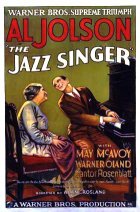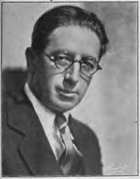
The Jazz Singer Page #5
- UNRATED
- Year:
- 1927
- 88 min
- 1,327 Views
--George Jessel
Back to scene. Jack asks the boy if he can see Mr. Schuler.
101.CLOSE SHOT BOTH
The boy just looks up and snaps out that "it car,'t be done -- he's in
an important conf'rence." Jack hopelessly turns away and the boy
continues his mauling of the typewriter.
102.FULL SHOT ROOM
As Jack walks disconsolately over to the one vacant chair, the young man
hidden behind the copy of Variety looks up. He recognizes Jack and, with
a smile, he jumps up and they grab each other's hands.
103.CLOSE-UP BOTH
They exchange the usual greeting: "If it ain't my old partner of the
sticks, Jack Robin!" and Jack's return:
TITLE 29:
"--and the last time I saw you Buster Billings,you were getting ready to climb a side door
Pullman in Cheyenne."
Back to scene. They reminisce some more. Jack asks him what he is doing,
and Buster points hopelessly to the door of the inner office, saying,
"The same thing you are."
104.FULL SHOT ROOM
As they are talking, the boy suddenly jumps up as though answering a
buzzer and goes to the inner door. He opens it, listens to something
said within, nods, and closes the door. He walks to the rail and gives
the people sitting around the room a contemptuous look.
105.CLOSE-UP BOY
He pauses a moment as he feels the expectant eyes on him, and with the
cruelty of youth, he barks out at them:
TITLE 30:
"The boss ain't seeing anybody else today --you can all duck."
106.FULL SHOT ROOM
The occupants start getting up wearily. They start for the door. Jack
and Buster are the last to go. They pause in the doorway.
107.CLOSE SHOT BOTH
They look at each other and Jack says to him: "Where to?" Buster pauses
and says they can take a walk and stall around awhile. He adds:
TITLE 31:
"Later we'll go to Coffee Dan's. My old sidekick, Frank Tames, is the -- impresario down
there and we can bum a feed off him."
They start out of the door.
108.EXT. STREET
In the near foreground looking down the street is the entrance to the
Orpheum theater. The electric sign in front is lighted. The lighted sign
is suddenly extinguished to indicate that the show is over, and people
start coming out of the doors. This DISSOLVES INTO:
109.INT. THEATER BACKSTAGE FULL SHOT
The players who have just finished their act, the closing one on the
bill, a troupe of acrobats, are just going to their dressing rooms. A
door to one of the stage dressing rooms opens, and a girl dressed neatly
in street attire comes halfway out.
110. CLOSE-UP GIRL
She is a small blonde girl, dressed in excellent taste. She is calling
out to someone not in sight.
TITLE 32:
Mary Dale, of the "Little Follies" act, was notyet a headliner in her own right, but ambition
pointed the way to fame.
111.MED. SHOT GIRL
She comes out of the door and closes it behind her. She calls again, and
in the background another girl and a young man, Ben Thorpe, appear. The
girl is a tall, wise-looking blonde of about twenty-five and the young
man is tall, blond, and good-looking. They come up to Mary and there is
some talk as to where they are going.
112.CLOSE SHOT THREE
They argue a while, then Mary says: "Let's go over to Coffee Dan's."
Estelle says that she won't remain long. The young man takes each by an
arm and they start out.
FADE OUT:
FADE IN:
113.INT. COFFEE DAN'S FULL SHOT
The tables are pretty well filled by a fairly well-dressed crowd. Some
even are in evening clothes. There is a general air of hilarity, but no
drinking is in evidence. Next to a table filled by people in evening
clothes, their women bedecked with diamonds, is a table at which sit
several tough-looking characters. But there are not many of these. Men
waiters dash back and forth carrying mostly ham and eggs, the piece de
resistance of a Coffee Dan meal. At the piano on the platform sits Frank
James, tortoise shell-bespectacled musician and entertainer as well as
master of ceremonies. In the background, up near the platform, is a
small table at which sit Jack Robin and Buster Billings.
114.CLOSE-UP TABLE
Jack and Buster are eating heartily with all the gusto that
characterizes a healthy appetite that has been whetted by lengthy
fasting. They look up at Frank and grin happily.
115.CLOSE-UP FRANK
He looks down at them, gives them a signal, then walks to the edge of
116.FULL SHOT ROOM
Frank is trying to get the diners to be quiet. The people at the tables
gradually hush their noise. Jack and Buster shove their plates away in
complete satisfaction.
117.CLOSE-UP FRANK
He has a hand upraised as he looks over the crowd. Then he casts a look
down at Jack's table and winks as he starts announcing:
TITLE 33:
"And now I am going to ask Mr. Jack Robin tosing something. Mr. Robin is the famous tenor
from Petaluma."
Back to scene. He winks again as he looks down at the table.
118.CLOSE SHOT TABLE
Jack is shrinking back in an embarrassed manner. Buster reaches over and
claps him on the back, telling him to be a good sport, that they all do
it there, even the big ones in grand opera.
119.MED. SHOT TABLES
The people at the tables are looking at Jack and hammering on the tables
with their hammers in an encouraging manner.
Jack dumbly accuses Buster of framing him, but the latter just laughs.
Jack finally pulls himself together as he realizes that there is no out
for him.
121.MED. SHOT TABLE AND PLATFORM
As Frank leans down with hand extended, Jack stands up, straightens his
coat, and joins him. Frank gives him a hand and yanks him up on the
platform, where they go into a conference as to what Jack is to sing.
122.LONG SHOT FROM PLATFORM
Jack and Frank are in the foreground at the piano talking. In the
background, a group appears at the foot of the stairs just entering the
place. It is the group from the vaudeville theater. Mary is in front,
and as the head waiter motions to them, they enter the place and are
seated at a table just in front of the platform as Frank sits down at
the piano and starts playing for Jack, who has advanced to the edge of
the platform.
123.CLOSE-UP JACK
He starts to sing his song. (The song, which is to be Vitaphoned, should
be one especially written for the occasion, as any current number would
be out of date long before the picture has played every theater equipped
for Vitaphone by release time.)
The table at which Mary and her party are seated is in the immediate
foreground. They are paying attention only to the waiter who is standing
over them awaiting their orders, as Jack is singing. Mary, attracted by
his voice, looks away from the group wonderingly as she listens.
125.CLOSE-UP MARY
She is looking up at Jack curiously as she listens. This is something
new to her.
126.CLOSE-UP JACK
He is singing, his eyes aimed toward the back of the place. As though
feeling the attraction of Mary's gaze, his eyes slowly come down. As
they meet those of Mary, he gulps and almost breaks. With an effort, he
continues singing, his eyes on the girl.
Mary still has her eyes on the singer. The others of the group, Estelle
and Ben Thorpe, are looking at Jack as they see him looking intently at
Mary. They turn to her and start kidding her about her conquest. She
kids them in return and does not look at Jack again. She is again her
usually reserved self, a girl intensely interested in her work and
wrapped up in her career.
128.MED. SHOT JACK
He is bringing his song to a close. As he does, Frank gets up quickly
and shakes hands with him. Jack is embarrassed at this and, at Frank's
instigation, he turns and bows to the audience and jumps down from the
platform hurriedly as though in fear that he would be called on again.
129.FULL SHOT ROOM
The diners are applauding and pounding on the tables with their hammers.
Jack, in the background, is seen going to his table, where Buster rises
and slaps him on the back and compliments him on his work. The diners
are still applauding and Jack turns and bows to them. Buster tries to
get him to go up again but he shakes his head and sits down at his
table.
130.CLOSE-UP JACK AND BUSTER
Buster is still complimenting Jack, but the latter's eyes have wandered
to the table occupied by Mary and her companions. Buster follows his
gaze. His face lights up with recognition. Jack notes this and turning
to him eagerly says: "Do you know her?" Buster says: "Which her?" Jack
indicates Mary. Buster nods: "Sure I know her -- I'm going over and say
Hello." Jack starts to follow, then subsides, his eyes on Buster.
131.CLOSE SHOT MARY'S TABLE
Mary is saying to Thorpe:
Translation
Translate and read this script in other languages:
Select another language:
- - Select -
- 简体中文 (Chinese - Simplified)
- 繁體中文 (Chinese - Traditional)
- Español (Spanish)
- Esperanto (Esperanto)
- 日本語 (Japanese)
- Português (Portuguese)
- Deutsch (German)
- العربية (Arabic)
- Français (French)
- Русский (Russian)
- ಕನ್ನಡ (Kannada)
- 한국어 (Korean)
- עברית (Hebrew)
- Gaeilge (Irish)
- Українська (Ukrainian)
- اردو (Urdu)
- Magyar (Hungarian)
- मानक हिन्दी (Hindi)
- Indonesia (Indonesian)
- Italiano (Italian)
- தமிழ் (Tamil)
- Türkçe (Turkish)
- తెలుగు (Telugu)
- ภาษาไทย (Thai)
- Tiếng Việt (Vietnamese)
- Čeština (Czech)
- Polski (Polish)
- Bahasa Indonesia (Indonesian)
- Românește (Romanian)
- Nederlands (Dutch)
- Ελληνικά (Greek)
- Latinum (Latin)
- Svenska (Swedish)
- Dansk (Danish)
- Suomi (Finnish)
- فارسی (Persian)
- ייִדיש (Yiddish)
- հայերեն (Armenian)
- Norsk (Norwegian)
- English (English)
Citation
Use the citation below to add this screenplay to your bibliography:
Style:MLAChicagoAPA
"The Jazz Singer" Scripts.com. STANDS4 LLC, 2025. Web. 23 Feb. 2025. <https://www.scripts.com/script/the_jazz_singer_878>.







Discuss this script with the community:
Report Comment
We're doing our best to make sure our content is useful, accurate and safe.
If by any chance you spot an inappropriate comment while navigating through our website please use this form to let us know, and we'll take care of it shortly.
Attachment
You need to be logged in to favorite.
Log In